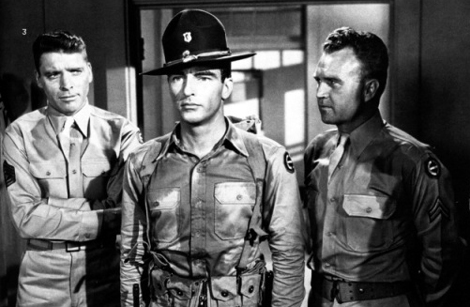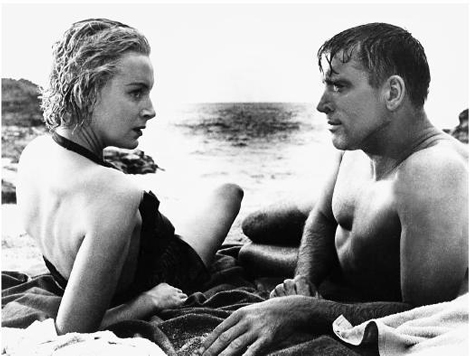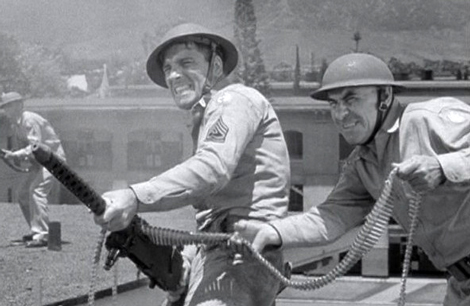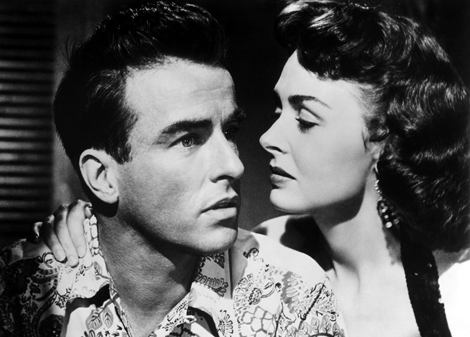Reviewed by Glenn Erickson
A whole generation of Americans lost its youth to the experience of World War 2, so much so that James Jones' honest, raw and profane book about Army life on Oahu just prior to the attack on Pearl Harbor made a huge cultural impact. In 1953 the book became one of the best-remembered postwar American movies. Columbia Pictures and director Fred Zinnemann succeeded in bringing what was considered an unfilmable novel to the screen in a way that satisfied the toughest fans of the book; not since Gone with the Wind had a literary adaptation won such unanimous approval. From Here to Eternity had sex, violence, great acting and an unkillable story about an event that every American alive considered central to his or her self-identity.

Hawaii, 1941. Pvt. Robert E. Lee Prewitt (Montgomery Clift) transfers to Schofield barracks, where the sports-minded C.O. Captain Holmes (Philip Ober) allows the non-coms to harass him for refusing to step back into the boxing ring. Under wearying punishments and humiliations, Prewitt finds time to make friends with the amiable but foolish Pvt. Angelo Maggio (Frank Sinatra), another potential stockade bird who makes the mistake of getting on the wrong side of Sgt. of the Guard Judson (Ernest Borgnine). The tough but inwardly sympathetic First Sgt. Warden (Burt Lancaster) manages to get Prewitt some passes into Honolulu, where he meets and falls in love with a 'hostess' at the New Congress Club, Lurene (Donna Reed). Prewitt's a hard case who just can't make things easy for himself, says Warden, even though Warden is busy pursuing an insanely risky affair with his own commander's wife, Karen (Deborah Kerr). As December 7 approaches, it's unclear who will still be in the service, or still be alive, to serve when the country goes to war.
From Here to Eternity won the approval of the country at large as well as the endorsement of members of the armed forces that remembered how things were between the wars. The U.S. Army was still called the Jock Strap Army, because the depression had made willing recruits so numerous that the various corps could pick and choose their enlistees, and often did so on the basis of what would best fill out their inter-service sports programs. Undersupplied and undertrained enlisted men marked time until the country needed them again. Even at a beautiful outpost like Hawaii soldiers were treated like 5th-class citizens, unwelcome when on leave and barely tolerated when on duty. Visit Hawaii now and you'll be astounded at how much of Oahu has been reserved for military use. The colonial buildings and concrete barracks seen in From Here to Eternity still stand, many purposely left pockmarked with battle damage as a reminder of the infamous attack.
For Columbia Pictures, this is a monumental production. The top talent traveled to Honolulu for filming, and the atmosphere of the beautiful islands comes through even in B&W. Suddenly a hot director thanks to High Noon, Zinnemann got his way on most of the creative decisions, especially the casting. Montgomery Clift is particularly brilliant as Prewitt, the hot bugler who refuses to 'play the game' set down by his brutal superiors. This might be the first Burt Lancaster role that isn't 100% a Burt Lancaster starring vehicle. He's truly good here, restrained from all of his action-movie histrionics, even though he does pop his characteristic grin every so often. Whether it was Zinnemann or not, somebody had the smart idea of casting two actresses associated with 'moral' roles to play the strumpet of an officer's wife, and the whore. The New Congress Club isn't much like it was portrayed in the book, but neither is it a church social.

This is of course the Frank Sinatra comeback role that Hollywood myth claims was obtained through mob pressure. Joan Crawford supposedly had the Karen Holmes part sewn up, but made too many early demands and was given the boot by a volatile Harry Cohn. Of such happy accidents great movies have been born.
The most amazing thing about From Here to Eternity is how darned efficient it is. In under two hours one feels as if the entire scope of the book has been covered. Daniel Taradash's adaptation knows just how to pace the scenes and what parts could be suggested instead of shown: my parents, watching it on television once, thought they remembered a scene where Ernest Borgnine really did beat up on Sinatra. Maggio's delivery to the sadistic Sergeant Judson is so well staged that viewers have no trouble imagining visuals for the 'missing' book chapter.
All Zinnemann need do was show two lovers in the surf, and the film suddenly had the hottest "sex" scene of 1953. It's just three cuts and an embrace, and yet it got by the censor. The realistic knife fight in the alley was also untouched by the blue scissor boys. In general, it seems clear that the perceived importance of James Jones' book forced the Production Code to give in. The bombing of Pearl Harbor is sketched with an action scene at the barracks, some newsreel footage and stock shots from John Ford's Navy films of WW2, which featured a few re-creations of the attack. Honolulu is represented by the clock tower on the main wharf, and the view of Diamond Head from Waikiki. One can still sit on the walkway where Lancaster and Kerr did.

Frank Sinatra's big dramatic scenes impressed civilian audiences, but military viewers would immediately pick up on more critiques of life in the Old Army. Showing an incompetent and abusive Company Commander is a shock, as is the admission that an Army stockade could harbor a sadistic warden. Although much tamer than the situations shown in the book (where Karen Holmes is a bad mother, not a tragic childless wife), the characters generally strike a note of authenticity. Most disturbing is the scene in which Donna Reed's dance hall "hostess" Lurene wails at the severely injured Prewitt as he attempts to rejoin his company. "What did the Army ever do for you!" she cries, protesting his devotion to a cruel institution seemingly determined to stamp out his spirit. I would say that hundreds of thousands of military wives sacrificing their lives to the service in return for poor pay and a low social standing identified very strongly with poor Lurene's pitiful situation.
Even though this was a 1953 film, the majority of the cast wasn't given screen billing. Memorable bits are covered by the likes of Claude Akins (one of the noncom boxers) Willis Bouchey & Carleton Young (colonels), George "Superman" Reeves (a sergeant friend of Warden), both Alvin and Joseph Sargent, and the irrepressible Joan Shawlee (The Apartment) as a good-time girl. Somewhere in there as well is John Veitch, who later became Columbia's head of production. Veitch was said to be a real veteran of Iwo Jima.
I'm not sure if there's a direct connection, but the personality conflict between Warden and Prewitt in this story is almost identical to that between the AWOL Private Witt and the sergeant Ed Welsh in James Jones' The Thin Red Line Are the two stories linked together? Time to go hunt up some pocketbooks and find out what James Jones is really like in print...
Sony's Blu-ray of From Here to Eternity is a clean encoding of one of the studio's top historical hits. The image shows a slightly exaggerated grain structure in some shots but has an excellent contrast range that enhances the realistic approach. This may be the first studio, Army-approved feature to skip the military glamour treatment. We can almost smell the barracks, with the soldiers lying in their bunks in their skivvies.
Ten years ago I made guesses as to the film's intended aspect ratio. It's since been determined that much of it was shot for 1:37, but that it premiered, as did the flat-filmed Shane, in widescreen. This is why the text blocks in the main titles look ready for 1:66 or 1:85. I'd have to guess that the poor projectionist throwing the picture on a wide screen would have to ride the framing knob to keep looking for a satisfactory composition. Sony wisely presents the film in its more sensible Academy screen shape.

The extras are mostly repurposed from older disc releases. A docu excerpt sandwiches an irrelevant film clip between two okay interview bites with director Zinnemann. The Making of... is a brief but interesting run through of the major casting decisions, etc., with some good BTS footage. And Fred's son Tim Zinnemann and Alvin Sargent are heard together on a commentary track.
Although its content would be easier to watch converted to a stand-alone docu, a "Graphics-in-Picture" track is an interesting enhanced trivia track. A great deal of relevant historical detail and references to the book are combined with talking head bites from numerous critics. Naturally there's a lot of content overlap within these extras; if one has the time the place to start is with this special trivia track, after seeing the film, of course.
After reading accounts of the impressive Deborah Kerr's career in England in the 1940s, it seemed wrong for the various spokespeople to keep referring to her as an actress likely to play only dignified, ladylike roles. Ms. Kerr was willing and able to take on a much wider range of assignments, if Hollywood would only have understood her (and women in general) better. Years later in John Frankenheimer's The Gypsy Moths, Kerr and Burt Lancaster reteamed for an impressively un-censored sex scene. Perhaps things would have been different if Alfred Hitchcock had cast Deborah Kerr as one of his icy blondes, hiding unexpected sensuality. She would have seemed perfect for that.
The packaging contains a welcome foldout with some little lobby card reproductions. Somebody was definitely having fun with Sony's Blu-ray cover graphic, which gives the impression that Burt and Deborah are making out on the beach while Japanese Zeros are shooting at them. That's exactly the kind of thing I would try back at MGM Home Video, only to be told to stop clowning around.
On a scale of Excellent, Good, Fair, and Poor,
From Here to Eternity Blu-ray rates:
Movie: Excellent
Video: Excellent
Sound: Excellent
Audio: English, French, Spanish and several other languages
Supplements: Commentary, featurettes, enhanced trivia track -- see above.
Deaf and Hearing Impaired Friendly?
YES; Subtitles: English and over twenty other languages
Packaging: Keep case in card sleeve
Reviewed: September 16, 2013

DVD Savant Text © Copyright 2013 Glenn Erickson
See more exclusive reviews on the Savant Main Page.
Reviews on the Savant main site have additional credits information and are often updated and annotated with reader input and graphics.
Also, don't forget the
2011 Savant Wish List.
T'was Ever Thus.
Return to Top of Page
|

